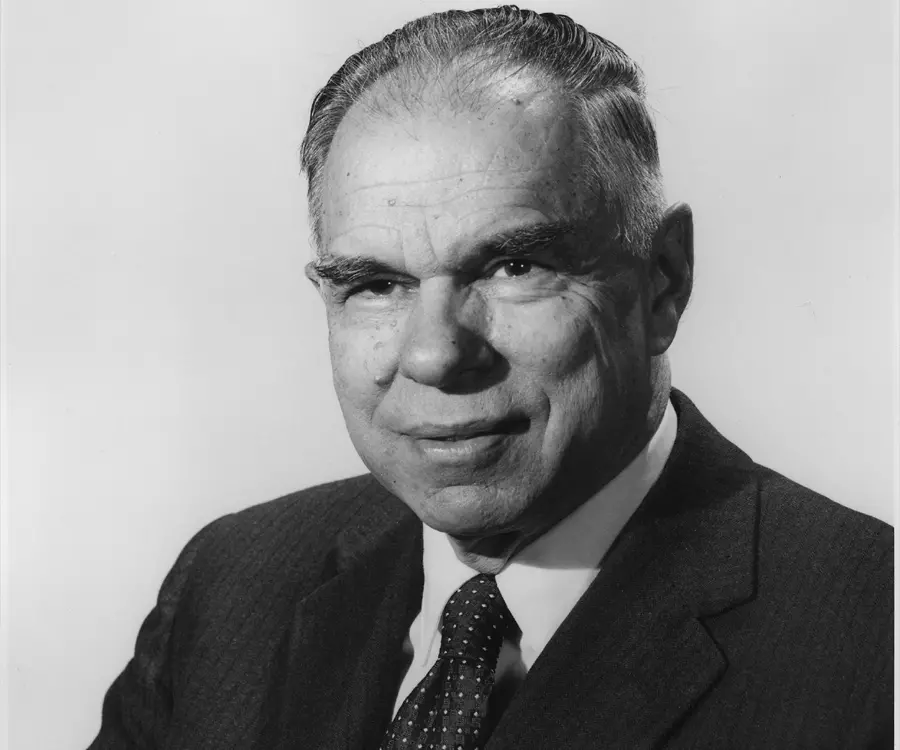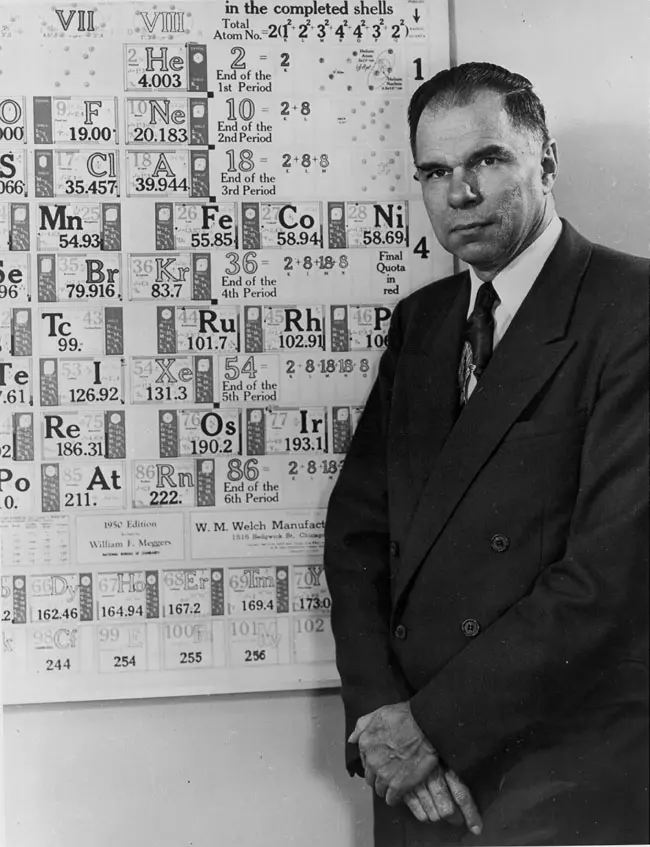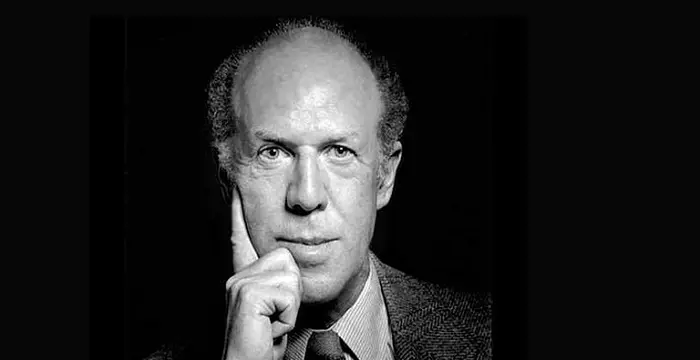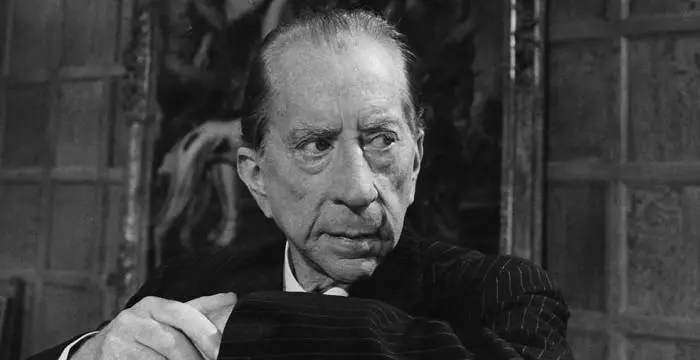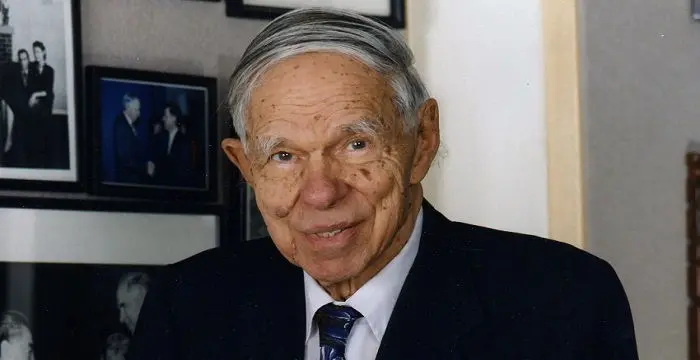
Glenn T. Seaborg - Chemists, Birthday and Childhood
Glenn T. Seaborg's Personal Details
Glen T
| Information | Detail |
|---|---|
| Birthday | April 19, 1912 |
| Died on | February 25, 1999 |
| Nationality | American |
| Famous | University Of California, Berkeley, Scientists, Chemists |
| Spouses | Helen Griggs |
| Known as | Glenn Theodore Seaborg |
| Childrens | David, Dianne, Eric, Lynne, Peter, Stephen |
| Universities |
|
| Notable Alumnis |
|
| Birth Place | Ishpeming, Michigan |
| Gender | Male |
| Father | Herman Theodore Seaborg |
| Mother | Olivia Erickson Seaborg |
| Sun Sign | Aries |
| Born in | Ishpeming, Michigan |
| Famous as | Chemist |
| Died at Age | 86 |
// Famous Scientists
Juliane Koepcke
Juliane Koepcke is a German-Peruvian biologist, who was the lone survivor among the 92 passengers and crew of the ill-fated LANSA Flight 508 that crashed in the Peruvian rainforest on 24 December 1971. Know more about her life in this biography.
Henry Cavendish
Henry Cavendish was a theoretical chemist and physicist, renowned for discovery of hydrogen and calculation of the mass of earth. To know more about his childhood, profile, timeline and career read on
Konstantin Tsiolkovsky
Konstantin Tsiolkovsky was a Russian rocket scientist and a pioneer of astronautics. This biography provides detailed information about his childhood, family, personal life, career, achievements, etc.
Glenn T. Seaborg's photo
Who is Glenn T. Seaborg?
Glen T. Seaborg was a Swedish-American nuclear chemist who was awarded the Nobel Prize in chemistry for the discovery of ‘Plutonium’. He shared the prize with another scientist, Edwin M. McMillan. Till that time Uranium was thought to be the heaviest metal in the Periodic Table. He and others worked together to discover the ‘trans-uranium elements’ including ‘element 94’ and more than 1000 other isotopes which changed Dmitry Mendeleev’s 1869 Periodic table significantly. He suggested the ‘actinide concept’ of the electronic structure of heavy elements that provided the relationship between the actinides and other elements in the Periodic table. Seaborg and his colleagues discovered nine more new ‘transuranium elements; such as americium, berkelium, curium, californium, fermium, einsteinium, nobelium, and mendelevium. The ninth element ‘element 106’ was named ‘seaborgium’ in his honor which was the first instance of an element to be named after a living person. He was not only famous for fundamental research in nuclear chemistry but also strongly supported and was committed to the education of science. He discovered radioisotopes like ‘cobalt-60’ and ‘iodine-131’ which are used to treat life-threatening diseases. He was an adviser to ten Presidents starting from Franklin D. Roosevelt to George H. W. Bush.
// Famous University Of California, Berkeley
Susan Sontag
Susan Sontag is an American critical essayist, cultural analyst, novelist, political activist, filmmaker and playwright of international repute. Read on to find out more about her childhood, career, profile and timeline.
Gerard Debreu
Gerard Debreu was a French-born American economist who brought mathematical precision to economics. Check out this biography to know about his childhood, family life, achievements and other facts related to his life.
J. Paul Getty
J. Paul Getty was an American billionaire businessman and president of the Getty Oil Company. This biography offers detailed information about his childhood, life, career and timeline.
Childhood & Early Life
Glen T. Seaborg was born in Ishpeming, Michigan on April 19, 1912.
His father was Herman Theodore Seaborg and his mother was Olivia Erickson Seaborg. He had a sister two years younger than him named Jeanette.
He graduated from the ‘David Starr Jordan High School’ in Los Angeles in 1929.
He joined the ‘University of California’ at Los Angeles in 1929 and received his B.A. in chemistry in 1934.
He earned his PhD in chemistry from the University of California, Berkeley in 1937.
Career
Glen Seaborg worked as a personal laboratory assistant of Gilbert N. Lewis at ‘University of California’ at Berkeley from 1937 to 1939 and was successful with physicist Jack Livingood in isolating ‘iodine-131’ used for treating thyroid problems.
He was appointed an instructor in chemistry at the ‘University of California’ at Berkeley in 1939, became an Assistant Professor in 1941 and a Professor in 1945.
In 1940 he discovered the ‘element 94’ later named ‘plutonium’ with the help of his colleagues, Joseph Kennedy, Edwin McMillan and Arthur Wahl.
From 1941 to 1955 he and his colleagues discovered nine more new elements with atomic numbers 95 to 102 and 106.
Seaborg, Louis B. Werner and Burris B. Cunningham first isolated plutonium on August 20, 1942.
During the Second World War, he worked at the ‘Chicago University Metallurgical Laboratory’ as the head of section dealing with plutonium for the ‘Manhattan Project’.
His team isolated, separated and concentrated plutonium for use in the atomic bomb at the ‘Clinton Engineering Works’ pilot plant at the Oakridge, Tennessee, and finally at the ‘Hanford Engineer Works, Richland, Washington.
In 1946 he returned to the ‘Lawrence Radiation Laboratory’ operated by the ‘University of California’ on behalf of the ‘Atomic Energy Commission’ and was its Associate Director from 1954 to 1961.
In 1954 he was appointed a member of the board of the first ‘General Advisory Committee’ for the ‘Atomic Energy Commission’ and held the post till 1960.
In 1958 he became the ‘Chancellor of the University of California’ and remained in that post till 1961.
In 1959 he helped found the ‘Berkley Space Sciences Laboratory’.
He was a member of the ‘President’s Science Advisory Committee’ from 1959 to 1961.
In 1961 President Kennedy appointed Seaborg as the Chairman of the ‘Atomic Energy Commission’ which he held till 1971.
In 1968 he laid the groundwork for the ‘Treaty on the Non-proliferation of Nuclear Weapons’.
In 1971 Seaborg returned to the ‘University of California’ at Berkeley as a professor and also as an associate director-at-large of the ‘Lawrence Berkeley Laboratory’.
He served as the President of the ‘American Association for the Advancement of Science’ in 1972 and as the President of the ‘American Chemical Society’ in 1976.
He served as the Chairman of the ‘Lawrence Hall of Science’ from 1984 to 1999.
In 1983 he brought out the report ‘A Nation at Risk: The Imperative for Educational Reform’ as a member of the ‘National Commission on Excellence in Education’
Major Works
Glenn T. Seaborg’s books ‘The Transuranium Elements’ and ‘Man-Made Transuranium Elements’ were published in 1958 and 1963 respectively.
‘Nuclear Milestones: A Collection of Speeches by Glenn T. Seaborg’ was published in 1972.
‘A Chemist in the White House: From the Manhattan Project to the end of the Cold War’ was published in 1998.
Awards & Achievements
Glenn Seaborg received the ‘Award in Pure Chemistry’ from the ‘American Chemical Society’ in 1947.
He received the ‘John Ericsson Gold Medal’ from the ‘American Society of Swedish Engineers’ and the ‘Nichols Medal’ from the ‘New York section of the Society of Chemical Industry’ in 1948.
He received the Nobel Prize in Chemistry in 1951.
He received the ‘John Scott Award and Medal’ from the ‘City of Philadelphia’ in 1953.
In 1957 he was awarded the ‘Perkin Medal’ by the ‘American Section of the Society of Chemical Industry’.
He won the ‘Enrico Fermi Award’ from the AEC in 1959.
In 1963 he was given the ‘Franklin Medal’ by the Franklin Institute, Philadelphia’.
He received the ‘National Medal of Science’ in 1991.
He was named the ‘Swedish American of the Year’ by the ‘Vasa Order of America, Stockholm’ in 1962.
The ‘Glenn T Seaborg Medal’ was been introduced in 1987 to honor scientists for their contributions to biochemistry and chemistry.
He received numerous honorary Doctor of Science degrees from the ‘University of Denver (1951), ‘Gustavus Adolphus College’ (1954), ‘North Western University’ (1954), ‘University of Notre Dame’ (1961), ‘Ohio State University’, ‘Florida State University’, ‘University of Maryland’ (1961), ‘Temple University’, ‘Georgetown University’, ‘University of the State of New York’ (1962), and ‘Mundelein College’, ‘Trinity College’ (1963).
He was given the degrees ‘Doctor of Humane Letters’ by the ‘Northern Michigan College’, ‘Doctor of Public Service’ by the ‘George Washington University’ and ‘Doctor of Public Administration’ by the ‘University of Puget Sound’ in 1962.
He received ‘Doctor of Laws’ from the ‘University of Michigan’ in 1962 and from the ‘University of Massachusetts’ in 1963.
Personal Life & Legacy
He married Helen Griggs, the secretary of Ernest O. Lawrence, in 1942 and had six children from the marriage named Peter, Lynne, David, Stephen, Eric and Dianne.
Glen Seaborg died in Lafayette, California on February 25, 1999 of stroke complications received in August 1998 during the meeting of the ‘American Chemical Society’.
Humanitarian Work
Glenn T. Seaborg campaigned for the peaceful use of atomic energy and was against the testing of nuclear weapons. Although he was actively involved in making the atomic bomb, he was against its use on the Japanese civilians.
Trivia
Glen T. Seaborg was fond of athletics and helped found the ‘Athletic Association of Western Universities’ in 1958.
His name has figured in the Guinness Book of World records as having the longest entry in ‘Who’s Who in America’.
// Famous Chemists
Henry Cavendish
Henry Cavendish was a theoretical chemist and physicist, renowned for discovery of hydrogen and calculation of the mass of earth. To know more about his childhood, profile, timeline and career read on
Walter Kohn
Nobel Laureate Walter Kohn was an Austrian-born American theoretical chemist and physicist. Check out this biography to know about his childhood, life, achievements, works & timeline.
Jabir Ibn Hayyan
Jabir Ibn Hayyan was a medieval era polymath. Check out this biography to know about his life, works and achievements.
Glenn T. Seaborg's awards
| Year | Name | Award |
|---|---|---|
Other | ||
| 0 | Franklin Medal (1963) | |
| 0 | Willard Gibbs Award (1966) | |
| 0 | Priestley Medal (1979) | |
| 0 | ForMemRS (1985) | |
| 0 | Vannevar Bush Award (1988) | |
| 0 | National Medal of Science (1991) | |
| 0 | Nobel Prize in Chemistry (1951) | |
| 0 | Perkin Medal (1957) | |
| 0 | Enrico Fermi Award (1959) | |
Glenn T. Seaborg biography timelines
- // 19th Apr 1912Glen T. Seaborg was born in Ishpeming, Michigan on April 19, 1912.
- // 1929He graduated from the ‘David Starr Jordan High School’ in Los Angeles in 1929.
- // 1929 To 1934He joined the ‘University of California’ at Los Angeles in 1929 and received his B.A. in chemistry in 1934.
- // 1937He earned his PhD in chemistry from the University of California, Berkeley in 1937.
- // 1937 To 1939Glen Seaborg worked as a personal laboratory assistant of Gilbert N. Lewis at ‘University of California’ at Berkeley from 1937 to 1939 and was successful with physicist Jack Livingood in isolating ‘iodine-131’ used for treating thyroid problems.
- // 1940In 1940 he discovered the ‘element 94’ later named ‘plutonium’ with the help of his colleagues, Joseph Kennedy, Edwin McMillan and Arthur Wahl.
- // 1941 To 1955From 1941 to 1955 he and his colleagues discovered nine more new elements with atomic numbers 95 to 102 and 106.
- // 1942He married Helen Griggs, the secretary of Ernest O. Lawrence, in 1942 and had six children from the marriage named Peter, Lynne, David, Stephen, Eric and Dianne.
- // 20th Aug 1942Seaborg, Louis B. Werner and Burris B. Cunningham first isolated plutonium on August 20, 1942.
- // 1947Glenn Seaborg received the ‘Award in Pure Chemistry’ from the ‘American Chemical Society’ in 1947.
- // 1948He received the ‘John Ericsson Gold Medal’ from the ‘American Society of Swedish Engineers’ and the ‘Nichols Medal’ from the ‘New York section of the Society of Chemical Industry’ in 1948.
- // 1951He received the Nobel Prize in Chemistry in 1951.
- // 1953He received the ‘John Scott Award and Medal’ from the ‘City of Philadelphia’ in 1953.
- // 1954 To 1960In 1954 he was appointed a member of the board of the first ‘General Advisory Committee’ for the ‘Atomic Energy Commission’ and held the post till 1960.
- // 1957In 1957 he was awarded the ‘Perkin Medal’ by the ‘American Section of the Society of Chemical Industry’.
- // 1958 To 1961In 1958 he became the ‘Chancellor of the University of California’ and remained in that post till 1961.
- // 1958 To 1963Glenn T. Seaborg’s books ‘The Transuranium Elements’ and ‘Man-Made Transuranium Elements’ were published in 1958 and 1963 respectively.
- // 1958Glen T. Seaborg was fond of athletics and helped found the ‘Athletic Association of Western Universities’ in 1958.
- // 1959In 1959 he helped found the ‘Berkley Space Sciences Laboratory’.
- // 1959 To 1961He was a member of the ‘President’s Science Advisory Committee’ from 1959 to 1961.
- // 1959He won the ‘Enrico Fermi Award’ from the AEC in 1959.
- // 1961 To 1971In 1961 President Kennedy appointed Seaborg as the Chairman of the ‘Atomic Energy Commission’ which he held till 1971.
- // 1962He was named the ‘Swedish American of the Year’ by the ‘Vasa Order of America, Stockholm’ in 1962.
- // 1962He was given the degrees ‘Doctor of Humane Letters’ by the ‘Northern Michigan College’, ‘Doctor of Public Service’ by the ‘George Washington University’ and ‘Doctor of Public Administration’ by the ‘University of Puget Sound’ in 1962.
- // 1962 To 1963He received ‘Doctor of Laws’ from the ‘University of Michigan’ in 1962 and from the ‘University of Massachusetts’ in 1963.
- // 1963In 1963 he was given the ‘Franklin Medal’ by the Franklin Institute, Philadelphia’.
- // 1968In 1968 he laid the groundwork for the ‘Treaty on the Non-proliferation of Nuclear Weapons’.
- // 1971In 1971 Seaborg returned to the ‘University of California’ at Berkeley as a professor and also as an associate director-at-large of the ‘Lawrence Berkeley Laboratory’.
- // 1972 To 1976He served as the President of the ‘American Association for the Advancement of Science’ in 1972 and as the President of the ‘American Chemical Society’ in 1976.
- // 1972‘Nuclear Milestones: A Collection of Speeches by Glenn T. Seaborg’ was published in 1972.
- // 1983In 1983 he brought out the report ‘A Nation at Risk: The Imperative for Educational Reform’ as a member of the ‘National Commission on Excellence in Education’
- // 1984 To 1999He served as the Chairman of the ‘Lawrence Hall of Science’ from 1984 to 1999.
- // 1987The ‘Glenn T Seaborg Medal’ was been introduced in 1987 to honor scientists for their contributions to biochemistry and chemistry.
- // 1991He received the ‘National Medal of Science’ in 1991.
- // 1998‘A Chemist in the White House: From the Manhattan Project to the end of the Cold War’ was published in 1998.
- // 25th Aug 1998 To 25th Feb 1999Glen Seaborg died in Lafayette, California on February 25, 1999 of stroke complications received in August 1998 during the meeting of the ‘American Chemical Society’.
// Famous American peoples
Wentworth Miller
Wentworth Miller is an American actor and screenwriter who achieved recognition for his role in the TV series ‘Prison Break’.
Jason Simpson
Jason Simpson is the son of former NFL running back, broadcaster and actor O. J. Simpson. Check out this biography to know about his childhood, family, life, and little known facts about him.
Melissa Brim
Melissa Brim is the ex-girlfriend of former professional boxer Floyd Mayweather Jr. Check out this biography to know about her birthday, childhood, family life, achievements and fun facts about her.
Skai Jackson
Skai Jackson is an American child actress with huge fan following. Find more about her family & personal life, relationships, facts and more.
Joyce Meyer
Joyce Meyer is a Christian author and speaker. This biography provides detailed information about her childhood, life, achievements, works & timeline
Zoe LaVerne
Zoe LaVerne is an American musical.ly star. Check out this biography to know more about her family, personal life, including her age, birthday, etc.
Glenn T. Seaborg's FAQ
What is Glenn T. Seaborg birthday?
Glenn T. Seaborg was born at 1912-04-19
When was Glenn T. Seaborg died?
Glenn T. Seaborg was died at 1999-02-25
Where was Glenn T. Seaborg died?
Glenn T. Seaborg was died in Lafayette, California
Which age was Glenn T. Seaborg died?
Glenn T. Seaborg was died at age 86
Where is Glenn T. Seaborg's birth place?
Glenn T. Seaborg was born in Ishpeming, Michigan
What is Glenn T. Seaborg nationalities?
Glenn T. Seaborg's nationalities is American
Who is Glenn T. Seaborg spouses?
Glenn T. Seaborg's spouses is Helen Griggs
Who is Glenn T. Seaborg childrens?
Glenn T. Seaborg's childrens is David, Dianne, Eric, Lynne, Peter, Stephen
What was Glenn T. Seaborg universities?
Glenn T. Seaborg studied at University Of California, Berkeley, UCLA, University of California, Berkeley
What was Glenn T. Seaborg notable alumnis?
Glenn T. Seaborg's notable alumnis is University Of California, Berkeley
Who is Glenn T. Seaborg's father?
Glenn T. Seaborg's father is Herman Theodore Seaborg
Who is Glenn T. Seaborg's mother?
Glenn T. Seaborg's mother is Olivia Erickson Seaborg
What is Glenn T. Seaborg's sun sign?
Glenn T. Seaborg is Aries
How famous is Glenn T. Seaborg?
Glenn T. Seaborg is famouse as Chemist



